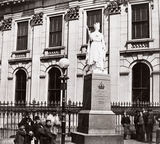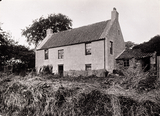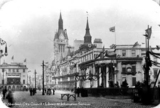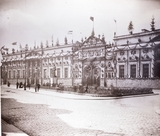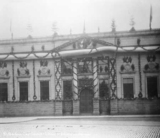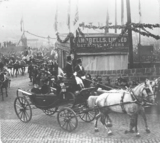|
Quick Search
|
Search Results
You searched for: More Like: 'Royal visit by Princess Beatrice'
41 items
items as
Statue of Queen Victoria
73 A photograph showing the statue of Queen Victoria at the junction of Union Street and St. Nicholas Street. The building in the background is the Clydesdale Bank that stands next to M&S today. This fine Italian renaissance style building was originally constructed for the Town and County Bank and opened for business in May 1863.
The statue of Queen Victoria was made from marble and was sculpted by Banff born Alexander Brodie (c.1829 - 1867). The origin of this statue is closely related to another Aberdeen monument, the 1863 memorial statue of Prince Albert by Baron Marochetti, now standing, or rather sitting, in the area in front of the Central Library.
Marochetti's statue was augurated by Queen Victoria herself on 13th October 1863 and this was said to the first time the Queen had appeared at a public demonstration following the death of Albert in 1861. The Marochetti statue was the subject of great local controversy and there were various plans for an alternative, superior, memorial to the late Prince Consort. It was at a related meeting that a chap called Alexander Donald, from the Royal Tradesman of Aberdeen, moved "That a colossal statue in marble, of Her Majesty, be erected at the corner of St. Nicholas Street."
The endeavour was taken on by a variety of prominent citizens and funding was raised by public subscription. Brodie, the selected sculptor, worked on an 11-ton block of Sicilian marble for two years to complete the statue. The finished piece is 8 foot 6 inches in height and, at the request of Queen herself, depicts Victoria in Scottish regal attire. The statue stands on a substantial plinth of pink Peterhead granite.
The statue was unveiled and inaugurated on 20th September 1866 by Albert-Edward Prince of Wales, later to be King Edward VII and the subject of another of Aberdeen's notable statues. During his speech at the ceremony, the Prince said "Gentlemen, it has afforded me the greatest satisfaction to attend here today, by the wish of Her Majesty, and at your invitation, for the purpose of inaugurating a statue of the Queen, my dear mother. Her Majesty has desired me to express to you how much she appreciates the motives which have led the people of Aberdeenshire to give this lasting evidence of their attachment and loyalty to her person, of which she has so many proofs, and whose sympathy in her great sorrow has touched her so deeply."
During his visit, the Prince of Wales also received the Freedom of the City and attended the Royal Horticultural Society's Autumn Show, which was then going on in the Music Hall. An extensive account of the unveiling, the Royal visit and the town's celebrations is given in the Aberdeen Journal of 26th September 1866.
After some time at this location, the statue's marble began to show weathering due to the frost and so it was moved to the vestibule of the Town House in 1888, where it remains to this day. It stands at the foot of the building's splendid main stairway. The plaster model of Brodie's statue has also been on display in the Music Hall for many years.
A new bronze statue of an older Victoria, by sculptor Charles Bell Birch, was erected at the St. Nicholas Street location on 9th November 1893 and "the Queen" became a regular meeting place for generations of Aberdonians. To make way for the extension of Marks & Spencer, the 1893 statue moved to its current site at Queen's Cross on 22nd January 1964. Victoria now stands looking east towards Balmoral. Honeybrae House
96 Honeybrae House. This house stood in the middle of a market garden near Morningfield Hospital about one-and-a-half miles west of Aberdeen City Centre. The lands were part of the old royal hunting forest of Stocket, given to the town of Aberdeen by Robert the Bruce. In the 17th century, it came into the ownership of the Skenes of Rubislaw and, in 1875, it was owned by Aberdeen Land Association. This two-storeyed house is most famous for its connection with the poet Lord Byron. In 1798, as a boy of about 10, he was taken there to spend a summer holiday while he was a pupil at Aberdeen Grammar School. At that time, it was probably a fairly new house, standing in its own grounds in a rural situation. He stayed there with his mother and their maid, Isabella Mitchell, before going to visit his old nurse, Agnes Gray. His room was on the first floor. By the 1830s, it was the home of a Captain John Boyd and later of market gardeners. Above the main door, there was a window whose thirteen small designed panes led it to be called 'the thirteen' window. By the 1920s, it had fallen into disrepair and the house was demolished in November 1928. The site was redeveloped for modern housing. St. Nicholas Churchyard façade decorated for a royal visit
735 The facade of St. Nicholas Churchyard on Union Street, decorated for a royal visit. Castlegate decorated for a Royal visit
737 Union Street at the Castlegate decorated for the visit of the King and Queen. Schoolhill decorated for a royal visit
776 Schoolhill, showing Aberdeen Art Gallery, the entrance to Robert Gordon's College and Gray's School of Art.
This image shows the buildings decorated for the city's celebrations of the coronation of Edward VII and Queen Alexandra that were held on Saturday 9th August 1902. The new monarchs had been crowned the previous year.
The decorations on Schoolhill and Rosemount Viaduct were carried out under the direction of Mr Stewart, superintendent of Stewart Park.
See the Aberdeen Daily Journal from Monday 11th August 1902 for an extensive report on the coronation celebrations. Aberdeen Art Gallery decorated for a Royal visit
787 The facade of Aberdeen Art Gallery, Schoolhill decorated for a Royal visit. Schoolhill decorated for a royal visit
796 Schoolhill, showing the Art Gallery and Gray's School of Art, decorated for a royal visit. Honeybrae House
816 Honeybrae House. This house stood in the middle of a market garden near Morningfield Hospital about one and a half miles west of Aberdeen City Centre. The lands were part of the old royal hunting forest of Stocket, given to the town of Aberdeen by Robert the Bruce. In the 17th century, it came into the ownership of the Skenes of Rubislaw, and in 1875, it was owned by Aberdeen Land Association. This two storeyed house is most famous for its connection with the poet Lord Byron. In 1798, as a boy of about 10, he was taken there to spend a summer holiday while he was a pupil at Aberdeen Grammar School. At that time, it was probably a fairly new house, standing in its own grounds in a rural situation. He stayed there with his mother and their maid Isabella Mitchell, before going to visit his old nurse, Agnes Gray. His room was on the first floor. By the 1830's, it was the home of a Captain John Boyd and later of market gardeners. Above the main door, there was a window whose thirteen small designed panes, led it to be called 'the thirteen' window. By the 1920's, it had fallen into disrepair and the house demolished in November 1928, and the site redeveloped for modern housing. Town House decorated for a royal visit
865 Town House decorated for the royal visit, 1906, to open the new extension of Marischal College. The Town House
1516 A photograph showing the Town House on Union Street decorated for a special occasion. The crests adoring the centre of the facade read "Long Live The King", which suggests the building is decorated for a Royal visit in the early 20th century. Duthie Park
1772 The opening of the Duthie Park in September 1883. The park was officially opened by Princess Beatrice, the youngest daughter of Queen Victoria. The park had been gifted to the city by Miss Elizabeth Crombie Duthie in 1880. Members of the Choral Union, who took part in the ceremony are standing in front of the platform.
Queen Victoria was originally intended to perform the opening ceremony but she sustained an accident earlier in the year and was unable to undertake the engagement. Princess Beatrice, the Queen's youngest daughter, then residing at Balmoral Castle, officially opened the park in her place on 27th September 1883.
The day was declared a public holiday and there were great celebrations throughout the city, concluding with a huge fireworks display over the River Dee. 1929 This illustration shows Queen Victoria receiving the keys of the City of Aberdeen in October 1857 as she travelled to the railway station after a summer spent at Balmoral. The Queen and the Prince Consort had travelled by coach the 60 miles from Balmoral to visit the Earl of Aberdeen at Haddo House on Wednesday 14th October. Their route was decorated with flags and arches at various points. A dinner, with a number of guests, including Lord Provost Webster of Aberdeen, was held at Haddo that evening and huge bonfires on surrounding hills lit the scene. On Thursday 15th October, the Queen and Prince Consort left Haddo, accompanied by the Earl and his son. More decorative arches had been erected on the roads south to Aberdeen. The Lord Provost, magistrates and councillors met the Queen at this Royal Arch near the city boundary at Love Lane (now Nelson Street) on King Street. The arch had been designed by the City Architect, William Smith. It was 15 feet wide, 26 feet high, with two smaller side arches. It was surmounted by the Royal Arms, flags and banners, with the words, "God save the Queen" and "Victoria", on either side in gilt letters. The side arches had the City motto, "Bon Accord", with floral crowns above, with flowers, evergreens and heather decorations. Many of the Guard of Honour wore the Crimean medal. The Lord Provost presented the silver keys on a velvet cushion to the Queen, who touched them, returned them to the Provost and said, "It affords me great gratification to be once more in my City of Aberdeen". The dignitaries returned to their coaches and the procession traveled on to Guild Street railway station, where, after a luncheon, the Royal Party now joined by the Royal children, who had come direct from Balmoral, boarded the train for Windsor. Aberdeen Harbour Board Offices
1939 The offices of the Aberdeen Harbour Board on Regent Quay. The building was designed by architect A. Marshall Mackenzie and constructed 1883-1885. In this image the building is decorated for special occasion, quite possibly a royal visit. Sir Alexander Lyon
2035 A portrait of Sir Alexander Lyon (1850-1926) in Lord Lieutenant's uniform. Alexander Lyon served as Provost of Aberdeen from 1905-1908. He died 26th April 1926 at his residence on Queen's Road, Aberdeen.
The Provost made the arrangements for the visit of King Edward and Queen Alexandra to Aberdeen in September 1906 for the opening of the extension of Marischal College. He was knighted during this royal visit. Lyon was also involved in the beach esplanade between the Rivers Dee and Don.
He held many public posts including; Deputy Lieutenant of the City and County of Aberdeen, a Justice of the Peace, president of the Aberdeen Territorial Army Association, a prominent office bearer in the Aberdeen Seven Incorporated Trades, a member of the West United Free Church, a member of the Cairngorm Club and the director of a number of important local businesses.
In August 1925 Alexander and Lady Lyon celebrated their golden wedding anniversary. Alexander Lyon
2056 A portrait of Sir Alexander Lyon (1850-1926). Alexander Lyon served as Provost of Aberdeen from 1905-1908. He died 26th April 1926 at his residence on Queen's Road, Aberdeen.
The Provost made the arrangements for the visit of King Edward and Queen Alexandra to Aberdeen in September 1906 for the opening of the extension of Marischal College. He was knighted during this royal visit. Lyon was also involved in the beach esplanade between the Rivers Dee and Don.
He held many public posts including; Deputy Lieutenant of the City and County of Aberdeen, a Justice of the Peace, president of the Aberdeen Territorial Army Association, a prominent office bearer in the Aberdeen Seven Incorporated Trades, a member of the West United Free Church, a member of the Cairngorm Club and the director of a number of important local businesses.
In August 1925 Alexander and Lady Lyon celebrated their golden wedding anniversary. Inauguration Ceremony
2213 The inauguration ceremony, during the royal visit, 1906, to open the new extension of Marischal College. This Fred Hardie image shows the University's then Principal, Rev John Marshall Lang, reading the inaugural address.
The inauguration took place at 1pm in the Marischal College quadrangle and was attended by various dignitaries and a large crowd.
To the left of Lang, who is holding his address by the granite pillar, is Sir Frederick Treves, rector of the University, Donald Alexander Smith (Lord Strathcona), the University's chancellor, Edward VII and Queen Alexandra.
See Record of the Celebration of the Quatercentenary of the University of Aberdeen, from 25th to 28th September, 1906 (1907) edited by P. J. Anderson, the University's librarian, for an account of the event and wider celebrations. Scottish North East Counties Constabulary - Traffic Department - 1962
2221 This photograph was taken in September 1962 at the Bridge of Don Barracks and just prior to the visit of HRH Princess Margaret to Fraserburgh and Peterhead.
The five officers shown are (left to right) Constables John Petrie, Hugh Matheson, Bob Davidson, Charlie Milne and Sergeant Charles Cruckshank. The notation below the images suggests the police officer on the right is Eric Simpson.
The four vehicles are (left to right) a Divisional Ford Transit van, an Austin A55 Patrol car, an Austin A99 Traffic car and a Jaguar Mk9 Traffic car.
(The above information was provided by Geoff Marston, Curator of the Grampian Police Heritage Museum, October 2015).
Treasure 6: Royal Horticultural Society of Aberdeen
2275 Enthusiastic gardeners who have spent months, if not years, nurturing their plants have the opportunity to display their efforts at flower shows - usually held in August or September. These events for individuals happen all around the country and have a long history.
Britain in Bloom is the national flower show for whole communities. It was the brainchild of Roy Hay, a horticultural journalist. Following a holiday in France where he admired the "Fleurissement de France", he persuaded the British Travel and Holidays Association (later the British Tourist Authority) to organise a similar competition for communities in Britain.
Although the first competition in 1964 was won by Bath, Aberdeen received a "Special Mention". The city did even better in 1965 when it won the National Trophy. Although it did not win again until 1969, the city then continued its success each year until 1971. However, this achievement led to Aberdeen being debarred from the National Competition in 1972 although it still won the Scottish section. 1973 and 1974 saw Aberdeen winning the National award again, and its record 10th win was in 1998.
A slogan competition was held for the 1968 campaign when the winning entry proclaimed "Aberdeen - Garden City by the Sea".
In order to celebrate Britain in Bloom and Aberdeen's success in the competition we have chosen to highlight our collection of historic prize schedules for the Royal Horticultural Society of Aberdeen's annual exhibition.
The Aberdeenshire Horticultural Society was founded in March 1824 when a meeting of "Practical Gardeners" was held in the New Inn for the "purpose of forming themselves into a Society". The Earl of Aberdeen graciously agreed to be Patron of the Society.
In November 1863, it was announced at the annual general meeting that HRH the Prince of Wales had now agreed to become Patron of the Society and that the Society's name was to be changed to the Royal Horticultural Society of Aberdeen.
The Society's "Prize Schedule for Exhibition" gives details of each of the classes which can be entered, with the prizes which can be won - a sum of money or a cup or medal. In 1920, there were a total of 222 classes and those who exhibited were split into one of four Divisions - professional gardeners; nurserymen and florists; amateurs and working class.
The Schedules also contain the Rules of Competition, the Constitution of the Society and a list of Subscriptions and Donations received - these include names, addresses and amounts given. Our earliest copies of the booklets cover the period 1920 - 1937, although the file is incomplete.
The Society celebrated its 175th anniversary in 1999. To take a closer look at these, and many other Aberdeen historic documents, visit Aberdeen Central Library. Royal Visit, 1971
3031 A photograph of Elizabeth II and Lord Provost James Lamond (29 November 1928 - 20 November 2007) at the Union Street entrance to the Town House. This image is thought to show a Royal visit on 8th December 1971.
This photograph comes from a collection of slides donated to Aberdeen City Libraries by Aberdeen City Council's publicity department. Royal Visit, 1971
3032 Elizabeth II entering the Union Street entrance to the Town House, followed by Lord Provost James Lamond. This image is thought to show a Royal visit on 8th December 1971.
This photograph comes from a collection of slides donated to Aberdeen City Libraries by Aberdeen City Council's publicity department.
Royal Visit, 1971
3033 Elizabeth II exiting her car and heading towards the Town House's Union Street entrance. A large crowd and the junction with Broad Street can be seen in the background. This image is thought to show a Royal visit on 8th December 1971.
This photograph comes from a collection of slides donated to Aberdeen City Libraries by Aberdeen City Council's publicity department. Royal Visit, 1971
3034 Elizabeth II and Lord Provost James Lamond outside the Town House on Union Street. This image is thought to show the Royal visit on 8th December 1971.
This photograph comes from a collection of slides donated to Aberdeen City Libraries by Aberdeen City Council's publicity department. |



